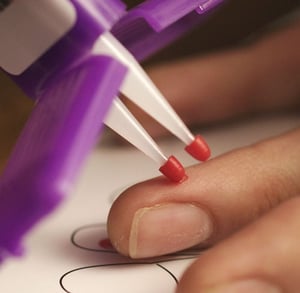Share this
monitoring immunosuppressive drugs: 5 benefits of remote sampling
by Neoteryx Microsampling on Mar 2, 2020 7:00:00 AM
 Immunosuppressive drugs are mandatory when a patient is going through procedures like organ or tissue transplantation, chemotherapy, or suffering from autoimmune diseases. This is because ISP drugs have a narrow therapeutic window. Fatal complications can develop using subtherapeutic doses.
Immunosuppressive drugs are mandatory when a patient is going through procedures like organ or tissue transplantation, chemotherapy, or suffering from autoimmune diseases. This is because ISP drugs have a narrow therapeutic window. Fatal complications can develop using subtherapeutic doses.
Therapeutic drug monitoring for immunosuppressive agents helps achieve the appropriate therapeutic effect and minimize risks. Whole blood specimens were required for sampling techniques like dried blood sampling. But a blood sampling technique like microsampling can reduce blood volume requirements.
Here are 5 benefits of using microsampling for ISP drug monitoring through blood tests:
1. Reduced Need for Large Blood Samples
With devices like the Mitra Collection Kit, analysts no longer need large blood samples. When the tip connects with fluid, its porous synthetic material is saturated with the biological fluid (20 microliters) through capillary action.
The tip is then dried, removed, and the analyte extracted, quantified, and analyzed for ISP concentrations. Small-sample volumes still enable researchers to measure drug concentrations with adequate precisions, selectivity, and sensitivity. Conventional extraction methods need samples as large as 50 microliters to analyze ISP concentrations.
2. Linearity of Results
Microsampling extraction methods may produce long term linear results across the six concentrations of ISP drugs with a small margin of error. For example, in cyclosporine, microsampling can have a slop acceptability of 1+0.15 and 1+/- 0.10 in tacrolimus and everolimus.
3. Toxicological Studies Improved
Microsampling may improve toxicology studies in ISP drug monitoring at a reduced cost. As such, a smaller sample is required for the tests eliminating the need for TK Satellite groups entirely. This significantly reduces the costs of the study.
4. Remote Patient Monitoring & Sampling
The development of microsampling devices like Mitra has made it possible for researchers to collect dried blood samples remotely using remote patient monitoring techniques. This patient centered approach makes ISP monitoring manageable for the patients. They don’t need to travel long distances to provide blood samples. Organ transplant recipients can provide samples wherever they are and ship them to clinics.
5. Precise Sampling Techniques
During the administration of tacrolimus, an ISP for kidney transplant patients, precise levels of the drug are required in the bloodstream to avoid rejection. Extremely high levels of tacrolimus increase a patient’s risk of developing high blood pressure, neurotoxicity, and post-transplant diabetes mellitus. More precise sampling methods are required.
Microsampling enables researchers to obtain a sufficient number of blood samples within each dose interval without restricting sampling time.

Share this
- Microsampling (206)
- Research, Remote Research (119)
- Venipuncture Alternative (105)
- Clinical Trials, Clinical Research (83)
- Mitra® Device (73)
- Therapeutic Drug Monitoring, TDM (51)
- Dried Blood Spot, DBS (39)
- Biomonitoring, Health, Wellness (30)
- Infectious Disease, Vaccines, COVID-19 (24)
- Blood Microsampling, Serology (23)
- Omics, Multi-Omics (21)
- Decentralized Clinical Trial (DCT) (20)
- Specimen Collection (18)
- Toxicology, Doping, Drug/Alcohol Monitoring, PEth (17)
- Skin Microsampling, Microbiopsy (14)
- hemaPEN® Device (13)
- Preclinical Research, Animal Studies (12)
- Pharmaceuticals, Drug Development (9)
- Harpera Device (7)
- Industry News, Microsampling News (5)
- Antibodies, MAbs (3)
- Company Press Release, Product Press Release (3)
- Environmental Toxins, Exposures (1)
- July 2025 (1)
- May 2025 (1)
- April 2025 (2)
- December 2024 (2)
- November 2024 (1)
- October 2024 (3)
- September 2024 (1)
- June 2024 (1)
- May 2024 (1)
- April 2024 (4)
- March 2024 (1)
- February 2024 (2)
- January 2024 (4)
- December 2023 (3)
- November 2023 (3)
- October 2023 (3)
- September 2023 (3)
- July 2023 (3)
- June 2023 (2)
- April 2023 (2)
- March 2023 (2)
- February 2023 (2)
- January 2023 (3)
- December 2022 (2)
- November 2022 (3)
- October 2022 (4)
- September 2022 (3)
- August 2022 (5)
- July 2022 (2)
- June 2022 (2)
- May 2022 (4)
- April 2022 (3)
- March 2022 (3)
- February 2022 (4)
- January 2022 (5)
- December 2021 (3)
- November 2021 (5)
- October 2021 (3)
- September 2021 (3)
- August 2021 (4)
- July 2021 (4)
- June 2021 (4)
- May 2021 (4)
- April 2021 (3)
- March 2021 (5)
- February 2021 (4)
- January 2021 (4)
- December 2020 (3)
- November 2020 (5)
- October 2020 (4)
- September 2020 (3)
- August 2020 (3)
- July 2020 (6)
- June 2020 (4)
- May 2020 (4)
- April 2020 (3)
- March 2020 (6)
- February 2020 (3)
- January 2020 (4)
- December 2019 (5)
- November 2019 (4)
- October 2019 (2)
- September 2019 (4)
- August 2019 (4)
- July 2019 (3)
- June 2019 (7)
- May 2019 (6)
- April 2019 (5)
- March 2019 (6)
- February 2019 (5)
- January 2019 (8)
- December 2018 (3)
- November 2018 (4)
- October 2018 (7)
- September 2018 (6)
- August 2018 (5)
- July 2018 (8)
- June 2018 (6)
- May 2018 (5)
- April 2018 (6)
- March 2018 (4)
- February 2018 (6)
- January 2018 (4)
- December 2017 (2)
- November 2017 (3)
- October 2017 (2)
- September 2017 (4)
- August 2017 (2)
- July 2017 (4)
- June 2017 (5)
- May 2017 (6)
- April 2017 (6)
- March 2017 (5)
- February 2017 (4)
- January 2017 (1)
- July 2016 (3)
- May 2016 (1)
- April 2016 (2)


No Comments Yet
Let us know what you think